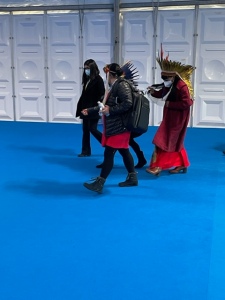ESA & COP26:: Day 2: Progress
This is a guest post by Andrew Barton, who is an ESA member attending COP26 in Glasglow, Scotland. Barton is a forest and fire ecologist, a writer, and a biology professor at the University of Maine at Farmington. This post was originally published on Barton’s blog The World Is on Fire. All photos and videos are by Barton.
by Andrew Barton
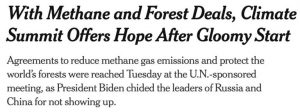 I won’t be surprised if this is news to you. These two deals have the potential to improve conditions on Earth much more than anything in the rest of the NYT combined, but I had to dig to find it, because of other political events.
I won’t be surprised if this is news to you. These two deals have the potential to improve conditions on Earth much more than anything in the rest of the NYT combined, but I had to dig to find it, because of other political events.
These two agreements, forged at COP26, over the past two days, are extremely important, and they sent hopeful ripples through the thousands of people at the conference. Methane is a greenhouse gas that has more heat-trapping power than CO2, although it also clears out of the atmosphere much faster than does CO2. Controlling the methane emissions, some of it from wasteful accidental release at natural gas wells, is critical for controlling global warming. The deforestation accord is especially encouraging because it has so many side benefits. Yes, it would reduce CO2 emissions when forests are cut down and, yes, it will increase the amount of forests that are taking CO2 out of the air through photosynthesis. But it will also help protect species and will provide indigenous communities with vital resources that they have sustainably tended for thousands of years (thank you very much!).
The question now is the rest of the deal. Will countries agree to make serious new cuts in their carbon emissions from fossil fuel burning? Will we leave COP26 joyful or will we leave with a mixed bag? Will we agree with the cover illustration below? Hopefully not.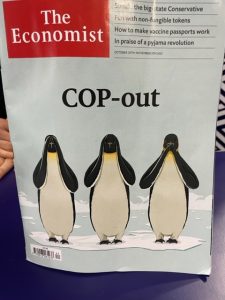
Much of the news regarding COP26 is about major agreements or lack thereof. “Top-down” solutions (e.g., countries agreeing to limit fossil fuel CO2 emissions) are obviously absolutely critical to staving off climate disaster for the planet. What the news doesn’t focus on, however, is “bottom-up” solutions. Let me give you a few examples.
I attend a panel talk/discussion on a project in Costa Rica that uses story telling and personal engagement to help people process, envision, and help with local solutions to climate change. A remarkable project!
Much of the news regarding COP26 is about major agreements or lack thereof. “Top-down” solutions (e.g., countries agreeing to limit fossil fuel CO2 emissions) are obviously absolutely critical to staving off climate disaster for the planet. What the news doesn’t focus on, however, is “bottom-up” solutions. Let me give you a few examples.
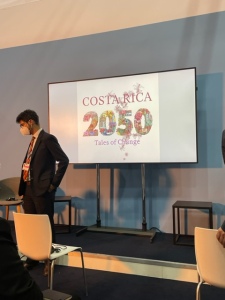 I attended a panel talk/discussion on a project in Costa Rica that uses story telling and personal engagement to help people process, envision, and help with local solutions to climate change. A remarkable project!
I attended a panel talk/discussion on a project in Costa Rica that uses story telling and personal engagement to help people process, envision, and help with local solutions to climate change. A remarkable project!
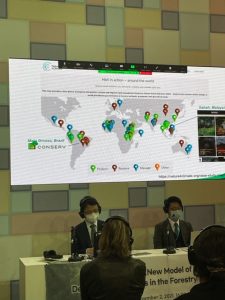
World map showing projects involved in this large-scale initiative
I went to another two-hour panel presentation, sponsored by South Korea, that described an emerging project, supported by multiple countries, companies, and environmental groups (mainly the Environmental Defense Fund) that will reduce deforestation, support local community use of forests, and provide money for technical assistance and scientific research. The companies involved also pledged to cut their emissions as part of this initiative.
There are hundreds — yes hundreds — of projects like these on display at COP26, from all parts of the world and with a wide range of emphases from energy efficiency, to forest protection, to indigenous rights…on and on. Although, the international agreements are crucial, these more “bottom-up” projects are heartening. In particular, it’s hopeful to see so many people, countries, organizations, and countries working on solving climate change. And there’s a lot of money flowing into these efforts. I attended a fascinating panel with world indigenous peoples leaders and the current president of COP26 (and the UN Framework on Climate Change). Finally…finally…the voices of indigenous people are beginning to be heard and supported (at least at COP26), and a great deal of money is flowing into the initiatives of these communities. Of course, as the leaders pointed out repeatedly, this is the kind of work they’ve been doing for centuries, for millennia.
So, I arrive at Wednesday Day 3 of COP26 a little more hopeful.
